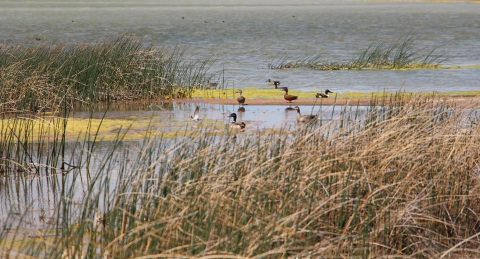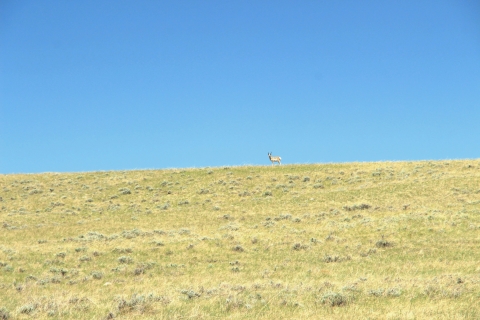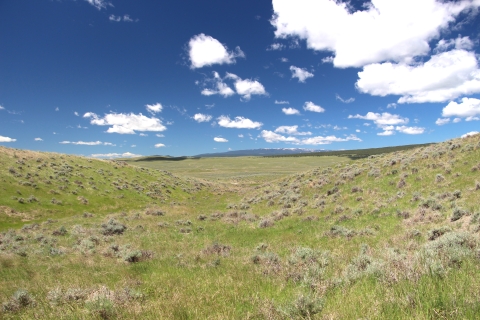About Us
The following are the Lake Mason National Wildlife Refuge units:
Lake Unit contains a 1,220-acre wetland - Lake Mason, and totals in excess of 6,216-acres in size. It hosts spectacular numbers of waterfowl and wading birds. During periods of dryness, exposed mudflats on the lake provide increased opportunities for shorebirds to feed. Mixed-grass prairie and shrublands make up most of the uplands around the lake. Several fields farmed prior to acquisition by the Service have been seeded to a dense nesting cover mixture of grasses and legumes for wildlife.
The prairie dog town located within the unit provides critical habitat for burrowing owls, horned larks, killdeer, thick-billed longspur, and mountain plovers, a Montana species of concern.
*The southern portion of this Refuge unit is open to hunting, wildlife observation, and wildlife photography. The northern portion of this Refuge unit is designated as permanent refugia for wildlife and is thus closed to all public entry and hunting.
Willow Creek Unit is 1,976-acres in size and is primarily comprised of intact native short-grass prairie with sagebrush sagebrush
The western United States’ sagebrush country encompasses over 175 million acres of public and private lands. The sagebrush landscape provides many benefits to our rural economies and communities, and it serves as crucial habitat for a diversity of wildlife, including the iconic greater sage-grouse and over 350 other species.
Learn more about sagebrush occurring along the southern boundary. This undisturbed short and sporadic mixed-grass prairie also contains abundant woody shrubs such as winterfat and saltbush. Pronghorn and mule deer are present in this unit, as well as occasional elk. Prairie dogs are also present and can provide critical habitat for occasional mountain plovers – a Montana bird species of concern. Similarly, western meadowlarks, along with other birds of state conservation concern such as the long-billed curlew, chestnut-colored longspur, and thick-billed longspur may also be found here. Their songs in spring and summer add to the intrinsic value of this Refuge unit. This Refuge unit is open to hunting, wildlife observation, and wildlife photography.
A cultural inventory of this unit revealed evidence of prehistoric occupation associated with buffalo hunts. During the late 1910s, most of the land in this area was homesteaded. Homesteaders earned their living raising livestock and grain until the Great Depression forced many to leave their land. Land ownership then reverted back to the government.
North Unit is 5,397-acres in size and is a large southern facing drainage basin having many coulees that contain a variety of native plants and grasses providing excellent habitat for small mammals, birds, and other wildlife. Mule deer, pronghorn and elk reside in the area. The sweeping grasslands interspersed with sagebrush in some areas of the North Unit are of particular importance to grassland nesting birds such as meadowlarks, bobolinks, Sprague’s pipits, greater sage-grouse, and Baird’s sparrows. This Refuge unit is open to hunting, wildlife observation, and wildlife photography.
Our Mission
The mission of the National Wildlife Refuge System is to administer a national network of lands and waters for the conservation, management and, where appropriate, restoration of the fish, wildlife and plant resources and their habitats within the United States for the benefit of present and future generations of Americans.
Our History
President Franklin D. Roosevelt signed Executive Order 8770 on June 3, 1941 that established Lake Mason Refuge “as a refuge and breeding ground for migratory birds and other wildlife”. At establishment, this Refuge was managed as a flowage and refuge easement. The Service acquired fee title lands within this refuge through a transfer authorized by the Bankhead-Jones Farm Tenant Act. The Bankhead-Jones Farm Tenant Act authorized the federal government to acquire damaged lands (lands homesteaded and later abandoned), rehabilitate these lands, and use them for various purposes. Executive Order 10787 (November 6, 1958) and Secretary’s Order 2843 (November 17, 1959) transferred jurisdiction of selected lands from the Secretary of Agriculture to the Secretary of Interior. It directed that these lands be “for use and administration under applicable laws as refuges for migratory birds and other wildlife.” These lands were received in scattered parcels of various sizes and provided a land base for this refuge and had been previously grazed or farmed.
Other Facilities in this Complex
Residing within the boundaries of the Charles M. Russell Wetland Management District, this Refuge is managed as part of the Charles M. Russell National Wildlife Refuge Complex. A National Wildlife Refuge Complex is an administrative grouping of two or more Refuges, wildlife management areas, or other Refuge conservation areas that are primarily managed from a central office location. Refuges are grouped into a complex structure structure
Something temporarily or permanently constructed, built, or placed; and constructed of natural or manufactured parts including, but not limited to, a building, shed, cabin, porch, bridge, walkway, stair steps, sign, landing, platform, dock, rack, fence, telecommunication device, antennae, fish cleaning table, satellite dish/mount, or well head.
Learn more about structure because they occur in a similar ecological region, such as a watershed or specific habitat type, and have a related purpose and management needs. Typically, a project leader or complex manager oversees the general management of all Refuges within the complex and Refuge managers are responsible for operations at specific Refuges. Supporting staff, composed of administrative, law enforcement, Refuge management, biological, fire, visitor services, and maintenance professionals, are centrally located and support all Refuges within the complex.
The District Manager for the Charles M. Russell Wetland Management District serves as the manager for Lake Mason National Wildlife Refuge.








